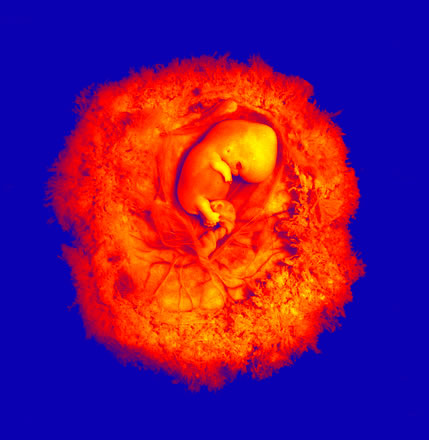Submitted by Administrator on Fri, 08/02/2019 - 11:50

Picture from the Boyd Collection held at the Loke Centre for Trophoblast Research.
HEART DISEASE STARTS IN THE WOMB: NEW ARTICLE BY PROFESSOR DINO GIUSSANI, Loke CTR MEMBER.
OUR CARDS MAY BE MARKED EVEN BEFORE WE ARE BORN...
A study led by Caius Professor Dino Giussani has discovered that babies born to pregnancies complicated with chronic hypoxia – lower-than-normal oxygen levels in the developing baby within the womb – may be at greater risk of heart disease in later life.
The findings, which have been published in PLOS Biology, suggest that our cards may be marked even before we are born, despite the widely accepted notion that our genes interact with traditional lifestyle risk factors, such as smoking and obesity, to promote an increased risk of cardiovascular disease.
“There is already evidence that the gene-environment interaction before birth may be just as, if not more, important in ‘programming’ future heart health than the effects of adult lifestyle,” said Dino Giussani, a member of Loke CTR and Professor of Developmental Cardiovascular Physiology & Medicine at Cambridge University. “For instance, human studies in siblings show that children born to a mother who was obese during pregnancy are at greater risk of heart disease than siblings born to the same mother after bariatric surgery to reduce maternal obesity. Such studies have provided strong evidence in humans that the environment experienced during critical periods of development can directly influence long-term cardiovascular health and heart disease risk.”
The Cambridge team used pregnant sheep to show that maternal treatment with the antioxidant vitamin C during a complicated pregnancy could protect the adult offspring from developing hypertension and heart disease – the greatest killer in the world today. The finding therefore not only provides evidence that a prenatal influence on later heart disease in the offspring is indeed possible, but also shows the potential to protect against it by “bringing preventative medicine back into the womb,” as Dr Kirsty Brain, first author of the study, puts it.
“Our discoveries emphasise that when considering strategies to reduce the overall burden of heart disease, much greater attention to prevention rather than treatment is required. Treatment should start as early as possible during the developmental trajectory, rather than waiting until adulthood when the disease process has become irreversible,” said Professor Giussani.
Vitamin C is a comparatively weak antioxidant, and while the Cambridge study provides a proof-of-principle, the team will now focus their attention on identifying alternative antioxidant therapies that could prove more effective in human clinical practice.
Dr Giussani's work comes as a useful complement to another Loke CTR member's work, Dr Amanda Sferruzzi-Peri. Amanda's recent publication in the Proceedings of the National Academy of Sciences suggests that the placenta can compensate in hypoxic pregnancy to protect the fetus from growth restriction under certain circumstances. Dr Giussani's work shows that this compensation does not extend to afford the offspring protection against cardiovascular disease in later life.
Read the freely available article in PLOS Biology.
ACKNOWLEDGEMENT: TEXT FROM THE PRESS RELEASE BY CAIUS COLLEGE CAMBRIDGE AND ADAPTED FROM A PRESS RELEASE BY PLOS BIOLOGY

